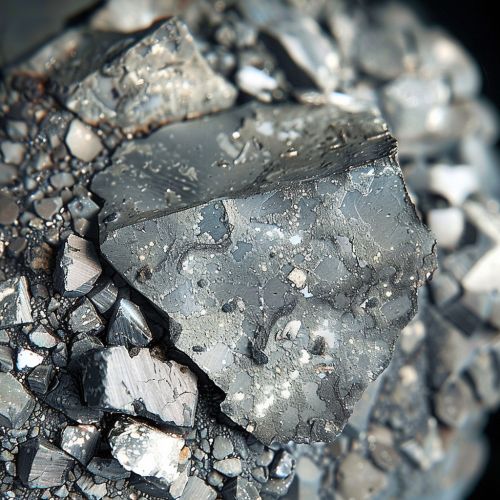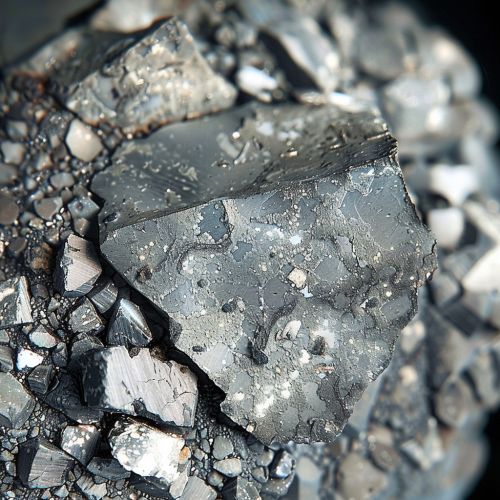Achondrite: Difference between revisions
(Created page with "== Introduction == Achondrites are a class of stony meteorites that do not contain chondrules, which are small, round particles found in most stony meteorites. They are formed from differentiated planetary bodies, meaning that they have undergone processes such as melting and differentiation, which separate them into different layers. This article delves into the detailed characteristics, classification, formation, and significance of achondrites. == Characteristics ==...") |
No edit summary |
||
| (One intermediate revision by the same user not shown) | |||
| Line 14: | Line 14: | ||
Achondrites display a variety of textures, from fine-grained to coarse-grained, and can be either equigranular or porphyritic. The textures provide clues about their cooling history and the environment in which they formed. | Achondrites display a variety of textures, from fine-grained to coarse-grained, and can be either equigranular or porphyritic. The textures provide clues about their cooling history and the environment in which they formed. | ||
[[Image:Detail-97323.jpg|thumb|center|Close-up image of an achondrite meteorite, showing its granular texture and mineral composition.|class=only_on_mobile]] | |||
[[Image:Detail-97324.jpg|thumb|center|Close-up image of an achondrite meteorite, showing its granular texture and mineral composition.|class=only_on_desktop]] | |||
== Classification == | == Classification == | ||
Latest revision as of 14:11, 27 July 2024
Introduction
Achondrites are a class of stony meteorites that do not contain chondrules, which are small, round particles found in most stony meteorites. They are formed from differentiated planetary bodies, meaning that they have undergone processes such as melting and differentiation, which separate them into different layers. This article delves into the detailed characteristics, classification, formation, and significance of achondrites.
Characteristics
Achondrites are primarily composed of silicate minerals, including pyroxene, plagioclase, and olivine. Unlike chondrites, achondrites lack chondrules and have a more complex geological history. They exhibit a wide range of textures and mineral compositions, reflecting their diverse origins and thermal histories.
Mineral Composition
The primary minerals in achondrites are:
- **Pyroxene**: A group of silicate minerals commonly found in igneous and metamorphic rocks.
- **Plagioclase**: A series of tectosilicate minerals within the feldspar group.
- **Olivine**: A magnesium iron silicate with a high melting point, commonly found in mafic and ultramafic rocks.
Texture and Structure
Achondrites display a variety of textures, from fine-grained to coarse-grained, and can be either equigranular or porphyritic. The textures provide clues about their cooling history and the environment in which they formed.


Classification
Achondrites are classified into several groups based on their mineralogy, texture, and isotopic compositions. The main groups are:
HED Meteorites
HED meteorites (Howardites, Eucrites, and Diogenites) are believed to originate from the asteroid 4 Vesta. They are named after the specific types of meteorites within this group:
- **Howardites**: Brecciated rocks composed of fragments of eucrites and diogenites.
- **Eucrites**: Basaltic rocks that are rich in pyroxene and plagioclase.
- **Diogenites**: Orthopyroxenites, primarily composed of orthopyroxene.
Martian Meteorites
Martian meteorites, also known as SNC meteorites (Shergottites, Nakhlites, and Chassignites), are believed to originate from Mars. They provide valuable information about the Martian crust and mantle.
Lunar Meteorites
Lunar meteorites are fragments of the Moon's surface that have been ejected by impacts and subsequently fallen to Earth. They are similar in composition to the rocks brought back by the Apollo missions.
Angrites
Angrites are a rare group of achondrites characterized by their unique mineralogy and high levels of calcium-aluminum-rich inclusions (CAIs). They are believed to have formed from a differentiated parent body.
Ureilites
Ureilites are ultramafic achondrites composed mainly of olivine and pyroxene, with a distinctive carbon-rich matrix. They are thought to originate from a partially differentiated parent body.
Formation and Origin
Achondrites are formed through processes that involve melting and differentiation of their parent bodies. These processes include:
Partial Melting
Partial melting occurs when a parent body heats up, causing some minerals to melt while others remain solid. The molten material can migrate and crystallize to form new rock types, leading to the formation of achondrites.
Differentiation
Differentiation is the process by which a parent body separates into different layers based on density and composition. This process results in the formation of a core, mantle, and crust, with achondrites representing material from these differentiated layers.
Impact Events
Impact events can cause fragments of differentiated bodies to be ejected into space. These fragments can eventually fall to Earth as meteorites, including achondrites.
Significance
Achondrites provide valuable insights into the processes of planetary differentiation and the history of the solar system. They are studied to understand the formation and evolution of planetary bodies, including asteroids, the Moon, Mars, and other celestial objects.
Planetary Differentiation
The study of achondrites helps scientists understand how planetary bodies differentiate into core, mantle, and crust. This knowledge is crucial for understanding the internal structure and thermal evolution of planets.
Solar System History
Achondrites contain isotopic signatures that provide information about the early solar system. By studying these isotopes, scientists can reconstruct the timeline of events that led to the formation of planets and other celestial bodies.
Comparative Planetology
Comparing achondrites from different parent bodies allows scientists to study the similarities and differences in planetary formation processes. This comparative approach helps to build a comprehensive picture of the solar system's evolution.
